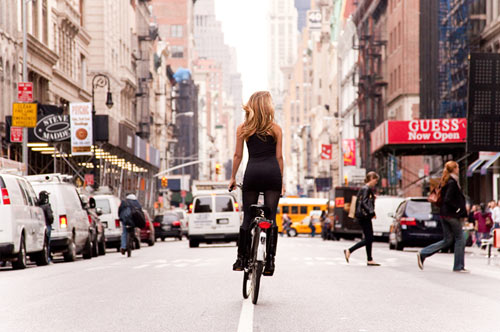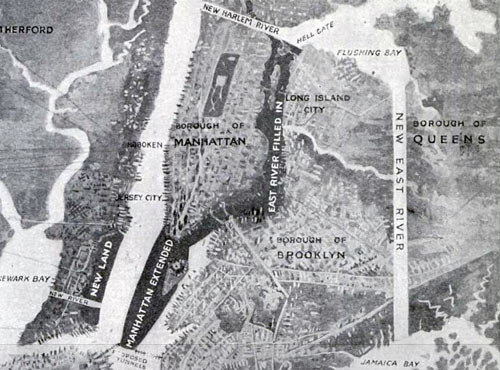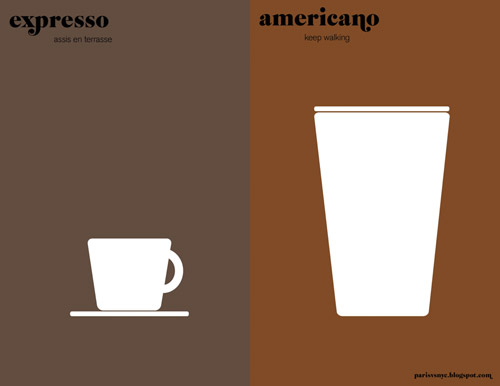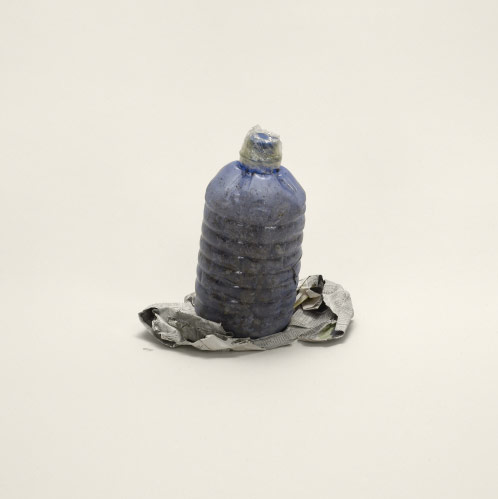Downtown from behind
If you crossed The Sartorialist with The Selby and put the whole thing on a bike, you’d get Downtown From Behind, a collection of photographs of creative people biking the streets of downtown Manhattan, shot from behind.




This site is made possible by member support. 💞
Big thanks to Arcustech for hosting the site and offering amazing tech support.
When you buy through links on kottke.org, I may earn an affiliate commission. Thanks for supporting the site!
kottke.org. home of fine hypertext products since 1998.
If you crossed The Sartorialist with The Selby and put the whole thing on a bike, you’d get Downtown From Behind, a collection of photographs of creative people biking the streets of downtown Manhattan, shot from behind.

Steven Johnson on what NYC and other cites are learning from services like 311.
But the service also helps city leaders detect patterns that might otherwise have escaped notice. After the first survey of 311 complaints ranked excessive noise as the number one source of irritation among residents, the Bloomberg administration instituted a series of noise-abatement programs, going after the offenders whom callers complained about most often (that means you, Mister Softee). Similarly, clusters of public-drinking complaints in certain neighborhoods have led to crackdowns on illegal social clubs. Some of the discoveries have been subtle but brilliant. For example, officials now know that the first warm day of spring will bring a surge in use of the city’s chlorofluorocarbon recycling programs. The connection is logical once you think about it: The hot weather inspires people to upgrade their air conditioners, and they don’t want to just leave the old, Freon-filled units out on the street.
The 311 system has proved useful not just at detecting reliable patterns but also at providing insights when the normal patterns are disrupted. Clusters of calls about food-borne illness or sanitary problems from the same restaurant now trigger a rapid response from the city’s health department.
Not discussed in the article is an assertion by my pal David that exclusive access to 311 data gives incumbent politicians — like, say, Michael Bloomberg — a distinct advantage when it comes to getting reelected. For instance, when campaigning on a neighborhood level, the incumbent can look at the 311 data for each neighborhood and tailor their message appropriately, e.g. promising to help combat noise in a neighborhood with lots of noise complaints or fix the streets in a neighborhood with lots of calls about potholes.
The NY Times has a photo slideshow of some NYC marathon participants right after they crossed the finish line yesterday. Why don’t any of them look exhausted?
If you’re running the NYC marathon tomorrow, have an iPhone, and are a Foursquare user, 4SQ CEO Dennis Crowley has the low-down on how to track your progress throughout the race by auto-checking-in to 4SQ at all the mile markers.
I’m going to use Mayor Maker tomorrow during the NYC Marathon to auto check me in to every mile marker as I run past them. I’ll be running w/ my iPhone in my pocket (with GPS turned on). Every time I run over a mile checkpoint, Mayor Maker will send that checkin to foursquare and foursquare will send it back out to Facebook and Twitter. Cool, right?
This was filmed in 1899 from a train crossing the Brooklyn Bridge from Brooklyn to Manhattan by Edison Manufacturing Co.
The film sold for $22.50 in the Edison films catalog.
New York, the documentary film by Ric Burns, contains a great segment on the Empire State Building that is available on YouTube in three parts.
The first two parts are particularly interesting, especially the construction stuff that starts around the five minute mark of part one. Oh, and don’t miss the steelworkers throwing red hot rivets around to each other…that starts right near the end of part one and continues into part two. Some other highlights:
- The original Waldorf-Astoria hotel was torn down (with no small amount of glee from the ESB’s developers) to make room for the new skyscraper. The hotel was built by William Waldorf Astor, heir to the forture created by his father and grandfather (John Jacob Astor & John Jacob Astor III), on the site of his father’s mansion. WW Astor’s cousin, John Jacob Astor IV, went down on the Titanic and the Senate hearings into the disaster were held at the hotel.
- The steel beams were custom forged in Pittsburgh and shipped immediately to the building site…some arrived still hot to the touch from the furnaces.
- At the peak of construction, the workers were adding 4-5 stories a week. During one 22-day stretch, 22 new floors were erected. From start to finish, the entire building took an astonishing 13 months to build, about the same amount of time recently taken by the MTA to fix the right side of the stairs of the Christopher St subway station entrance.
- The building didn’t become profitable until 1950.
(thx, lily)
An interesting interview with the anthropologist-in-residence of the NYC Department of Sanitation.
The money set aside for street cleaning was going into the pockets of the Tweed and Tammany politicians. Eventually, it got to be that it was so dirty for so long, no one thought that it could be any different. Imagine, on your own block, that you can’t cross the street, even at the corner, without paying a street kid with a broom to clear a path for you, because the streets were layered in this sludge of manure, rotting vegetables, ash, broken up furniture, debris of all kind. It was called “corporation pudding” after the city government. And it was deep — in some cases knee-deep.
Steven Johnson on why New York has become a growing hub for technology startup companies.
As a diverse city that supports countless industries and maverick interests, New York excels at creating those eclectic networks. Subcultures and small businesses generate ideas and skills that inevitably diffuse through society, influencing other groups. As the sociologist Claude Fischer put it in an influential essay on subcultures published in 1975, “The larger the town, the more likely it is to contain, in meaningful numbers and unity, drug addicts, radicals, intellectuals, ‘swingers’, health-food faddists, or whatever; and the more likely they are to influence (as well as offend) the conventional center of the society.”
In 1916, Kennard Thomson, consulting engineer and urban planner for New York City, wrote an article for Popular Mechanics in which he advocated (among other things) filling in the East River to merge Manhattan with Brooklyn.

By Dr Thomson’s estimates, enlarging New York according to his plans would cost more than digging the Panama Canal - but the returns would quickly repay the debt incurred and make New York the richest city in the world. He then goes on to describe how he would reclaim all that land. The plan’s larger outlines: move the East River east, and build coffer dams from the Battery at Manhattan’s southern tip to within a mile of Staten Island, on the other side of the Upper Bay, and the area in between them filled up with sand. This would enlarge Manhattan to an island several times its present size.
Proximity and easy access to the new Battery would increase the total land value of Staten Island from $50 million to $500 million. “This would help pay the expenses of the project,” Dr Thomson suggests.
The project would also add large areas of land to Staten Island itself, to Sandy Hook on the Jersey shore just south of there and create a new island somewhere in between. The East River, separating Manhattan from Queens and Brooklyn, would be filled and replaced by a new canal east of there, slicing through Long Island from Flushing to Jamaica Bays.
The Paris vs New York blog presents a series of illustrated comparisons between the two cities: macaroons vs. cupcakes, baguette vs bagel, and espresso vs American coffee:

Kenji Lopez-Alt learns the secret to the perfectly poached eggs at Maialino. They basically use the Momofuku slow-poach technique and then finish in a simmering water bath.
Mary HK Choi observes that NYC’s men have suddenly learned how to dress and now she can’t tell who’s who anymore, socioeconomically speaking.
I can’t figure out how old anyone is. I can’t figure out how gay anyone is. On silent subway morning commutes there are no tells. The brogues, desert boots and quickstrike high-tops not only have me manic-fantasy-banging every well-dressed dude on the F BECAUSE IT IS ALL SO GODDAMN GOOD but the fact that so many are suddenly well shod plus the prevalence of hard-bottoms straight CRIPPLES my ability to tell how rich anyone is. And that is fucking my game up major. Aaaaaaaaaand everyone’s watch is now the old timey Timex from J.Crew for $150 so yeah, 360 IDK. Plus, also, seriously, there must have been some clandestine colloquium workshop situation where all the dudes in all the land shucked to skivvies and got sized for their perfect pair of Uniqlo jeans and nobody said “no homo,” not even one time, because, Hi, y’all all look fantastic FUCK YOU.
Slideshow of almost 100 years of photography of the NYC subway system by the NY Times.

The caption for the photo above reads:
1940: In a view north from 106th Street, only the supports of the old Ninth Avenue elevated line remained as the push to go underground continued.
If you’re in NYC, they’re showing the restored version of Fritz Lang’s Metropolis (including 25 minutes of recently discovered footage) at the Ziegfeld on West 54th from Oct 22 - Nov 4.
If you’re not in NYC, the complete Metropolis is out on Blu-ray and DVD on Nov 16.
DesigNYC connects non-profits with designers; they’ve just announced their second call for project submissions and designers:
We’re proud to announce the second call for submissions for project ideas and design collaborators. DesigNYC will select the most compelling projects and match them with design leaders across the fields of architectural, landscape, interior, lighting, and communication design.
Our projects focus on the themes of well-being and sustainable communities — creating solutions that address a range of social and environmental issues impacting the city, including affordable housing, sustainable development, social justice, human health, green space, urban farming, local food systems, youth leadership, and more.
Designers and non-profits can sign up here.
Eater has an interview with Gabe Stulman and Jim McDuffee, proprietors of Joseph Leonard, on how the first year of their West Village restaurant went. Watching the chefs make such good food out of such a small kitchen an impressive spectacle.
The limitations that we have are, I think, severe. We don’t have a freezer, anywhere. We don’t have ice cream or sorbet, we don’t have anything that needs to be frozen, it’s all fresh, fresh, fresh. We’ve got refrigerators touching each other over there. We’ve got ten burners, two ovens, a fryer and a salamander. That’s what most people have as a prep kitchen. It’s really impressive when I look at how we’ve got five seafood entrees, five meat entrees, thirteen appetizers, all done with these varying, beautiful techniques and preparations. I tip my hat to everything that Jim and the team in the kitchen have been able to pull off.
It took awhile for my wife and I to warm up to it, but Joe Leo is our go-to neighborhood restaurant now. On our one child-free night out a week, we generally end up there.
Starting tomorrow and continuing through November, Pratt Manhattan Gallery has an interesting show about maps and NYC. Among the works displayed will be:
- a three-dimensional map of the lower Manhattan skyline made of a Jell-O-like material by Liz Hickok
- a “Loneliness Map” from Craigslist’s Missed Connections by Ingrid Burrington
- personal maps created from a call for submissions by the Hand Drawn Map Association
- Bill Rankin’s maps of Not In My Back Yard-isms showcasing various geographies of community and exclusion
- a scratch-and-sniff map of New Yorkers’ smell preferences by Nicola Twilley
Opening reception is tonight from 6-8. (via edible geography)
John Hodgman is filming a pilot for an HBO show called Good Evening, My Name is John Hodgman. Jonathan Coulton and Spike Jonze are involved.
THE THEME OF THIS PARTICULAR PROGRAM is “JOCKS vs. NERDS,” the culture war of our time, and a subject that you know I have been thinking about for some time now, and also talking about with the PRESIDENT OF THE UNITED STATES.
IN THIS CASE, the “NERD” shall be played by me, John Hodgman, and the “JOCK” shall be played by the New York Jet, NICK MANGOLD, as I confront all of my deepest fears (humiliation/being punched/Nick Mangold) and attempted to learn from him the virtues of jock culture and the rules of football.
And YOU are invited: September 28th in NYC. Tickets are free and they have an unlimited supply because they are filming it in some sort of massive rocket ship hanger. All you Little Hobos (that’s what Hodgman calls all his fans) click through for details on how to get your tickets.
This week’s Geeking Out, Gelf Magazine’s nerdy event series, is all about NYC transportation.
The evening will feature Benjamin Kabak (Gelf interview), author of popular subway blog Second Avenue Sagas discussing the MTA; Sharon Zukin (Gelf interview), author of Naked City: The Death and Life of Authentic Urban Places, on gentrification; and Charles Komanoff (Gelf interview), creator of the Balanced Transportation Analyzer, discussing how to optimize the city’s transportation network.
Free. Sept 16, 7:30p in Dumbo. Click through for more details.
Cutting through parking lots, hotels, and department stores, Tad Friend one-ups John Updike by walking all the way from 33rd Street to Central Park without walking on 5th or 6th Avenues.
It was after 5 P.M., so I ducked in for a drink a few doors down at the Whiskey Trader bar, where the weekend was noisily under way. Downstairs, by the rest rooms, was a door with a sign warning “Siren Will Sound.” But siren didn’t sound. In the adjacent basement were a mop and a bucket, odds and dead ends-and a stairwell, leading up. On the landing I eased open a fire door… into a gleaming lobby off Fifty-sixth. Ha!
Updike only made it to Rockefeller Center. You may remember a similar effort from last year. Who will take up Friend’s mantle and stretch this down to 14th Street? And would Broadway be allowed? (I think not.)
The MTA in NYC is looking for someone to keep their transit maps fresh.
As part of a two-person team, the incumbent of this position is responsible for the design and timely updating of NYCT’s printed and online map products, including the extensive service schedule panels on the reverse side of all “pocket” bus maps; researching and responding to map design and information issues; identifying, researching, recommending, and adapting evolving map drawing and production technologies; adapting Transit’s map products to the agency website and providing modified products for third party publications; advising on or producing custom maps for major agency initiatives and proposals; advising and assisting on other product design, graphics technology procurements and related staff training for all graphics services in Marketing and Service Information.
This has to be some kottke.org reader’s dream job…go get it!
Felix Salmon’s dissection of the awkward and often dangerous pedestrian/bike/car dance on NYC’s streets is exactly right. If this was a manifesto, I’d sign it.
Bikes can and should behave much more like cars than pedestrians. They should ride on the road, not the sidewalk. They should stop at lights, and pedestrians should be able to trust them to do so. They should use lights at night. And — of course, duh — they should ride in the right direction on one-way streets. None of this is a question of being polite; it’s the law. But in stark contrast to motorists, nearly all of whom follow nearly all the rules, most cyclists seem to treat the rules of the road as strictly optional. They’re still in the human-powered mindset of pedestrians, who feel pretty much completely unconstrained by rules.
The result is decidedly suboptimal for all concerned, but mostly for the bicyclists themselves. New York needs to make a collective quantum leap, from treating bicyclists like pedestrians to treating bicyclists like motorists. And unless and until it does, bike relations will continue to be marked by hostility and mistrust.
This car/pedestrian duality in the manner in which bicyclists behave is also why the City’s Summer Streets initiative is becoming almost unusable by pedestrians. We tried walking on the last Summer Streets weekend, but the cyclists were going way too fast, were routinely weaving in and out of pedestrians, pretty much refused to stay in their lanes, and there were just too many for the width of the street. We bailed out after several blocks. There will likely be even more bikes next year because the word’s getting out: it’s just too dangerous for walking.
Susan Orlean writes about the lopsided intimacy of big cities and social media.
Life in Manhattan is like living inside a gigantic Twitter stream. What you get to know about people you don’t know simply by accidental adjacency is astonishing.
The only reason I ever go to MoMA anymore is so that my son can see the helicopter and whatever motor vehicles are on display in the design collection, but if I get a chance to sneak away soon, I’m definitely making use of the MoMA’s new iPhone app: tours, a catalog of thousands of works, events calendar, etc.
In a long excerpt from O’Reilly’s recent book “Beautiful Visualization”, KickMap designer Eddie Jabbour talks about his process for redesigning the NYC Subway map.
While I felt that it was important to show certain shapes aboveground, I also felt that it was important to leave out certain pieces of belowground information. There are several places where the subway tunnels cross and overlap each other beneath the surface. This may be important information for city workers or utility companies trying to make repairs, but for the average commuter, showing these interactions just creates visual noise. I tried to reduce that noise by cleanly separating the lines on the map so they don’t overlap. Consider the different depictions of the 4 line and the 5 line in the Bronx; sure, the MTA’s paths may be accurate, but they’re also confusing, and riders don’t really need to see those particular details to understand where they’re going.
(Via @TheJames)
Taryn Simon spent five days photographing items confiscated from people flying into New York’s JFK airport. This one is “mystery meat”:

These images are from a set of 1,075 photographs — shot over five days last year for the book and exhibition, “Contraband” — of items detained or seized from passengers or express mail entering the United States from abroad at the New York airport. The miscellany of prohibited objects — from the everyday to the illegal to the just plain odd — attests to a growing worldwide traffic in counterfeit goods and natural exotica and offers a snapshot of the United States as seen through its illicit material needs and desires.
Here’s more about the project, which will be released in book form and also put on display in galleries in LA and NYC.
Meant to post about this when it was announced: the Brand New Conference, Nov 5 in NYC.
The Brand New Conference is a one-day event organized by UnderConsideration, focusing on the practice of corporate and brand identity — a direct extension of the popular blog, Brand New. The conference consists of eight sessions offering a broad range of points of view with speakers from around the world practicing in different environments, from global consultancies, to in-house groups, to small firms.
Speakers include boldface names Michael Bierut, Paula Scher, and Erik Spiekermann. Surprisingly, tickets are still available.
NY Times readers recently had a bunch of their questions answered by a NYC window washer. (This is more interesting than it sounds.)
For safety reasons, music and cellphones are not allowed up in the scaffolding, but some of us listen to our own music in our heads.
Here’s part two. (via @nicolatwilley)
The Library of Congress has uploaded a whole bunch of early film footage of NYC to their YouTube account. Like this 1905 pararama from the top of the Times Building in Times Square:
Open Culture has more information. (via @brainpicker)
Last year, the New Yorker ran a story on NYC’s Rubber Rooms, the common name for the rooms which house NYC schoolteachers accused of classroom misconduct.
The teachers have been in the Rubber Room for an average of about three years, doing the same thing every day — which is pretty much nothing at all. Watched over by two private security guards and two city Department of Education supervisors, they punch a time clock for the same hours that they would have kept at school — typically, eight-fifteen to three-fifteen. Like all teachers, they have the summer off. The city’s contract with their union, the United Federation of Teachers, requires that charges against them be heard by an arbitrator, and until the charges are resolved — the process is often endless — they will continue to draw their salaries and accrue pensions and other benefits.
Yesterday, the Rubber Rooms were finally closed down. It seems like a purely cosmetic move; the real problems outlined in the NYer article remain unaddressed. Shouldn’t the Times article at least mention that?
Stay Connected